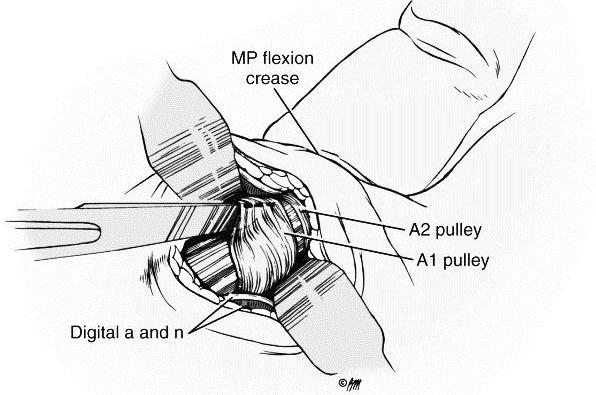Percutaneous Trigger Finger Knife

Trigger finger is common among middle-age men and women. It is caused by nodules in the tendons that trigger as they pull through the tight pulleys causing sticking of the fingers, pain and impairment of the hand. In the beginning, the patient experiences little pain and sticking of the fingers, which can be treated by taking anti-inflammatory medicines. Patients who do not respond to the medicines could be treated by injection of steroids or surgical treatment. Steroid injection however yields short-term results and patients are likely to experience relapses. Surgical treatments on the other hand could permanently rid of the problem. There are currently 2 types of surgical treatments: Open Trigger Finger Release and Percutaneous Trigger Finger Release.
Open Trigger Finger Release (picture 1) is a standard procedure in which a small incision, about 1.5 cm wide, is made at the base of the finger. Scissors or a knife is used to divide the pulley that is 1cm deep under the skin, then the incision is closed.
The disadvantages of Open Trigger Finger Release include opening of the skin could cause injury of the tissue around the incision, the procedure is more complex and requires extended recovery time. For these reasons, an alternative procedure called Percutaneous Trigger Finger Release is developed to offer benefits of smaller incision, faster recovery time, and simpler procedure (involve less surgical equipment, operation time, and personnel).
Percutaneous Trigger Finger Release is not yet common in Thailand due to lack of equipment and effective surgical techniques. Most surgeons use 18-gauge needle to insert through the skin and divide the thickened pulley that is causing the triggering. The main disadvantage is that the surgeon must rely on his sense and skills and the cutting of the pulley requires much guessing as there is no equipment indicating how deep the needle should travel under the skin. There is a possible higher risk of tearing of tendons and tissues around the pulley landmark that could cause chronic pain and pressure around the surgical site, sticking of the fingers, fascia of tendons restricting the movement of the finger, and permanent loss of finger movement. Moreover, if the needle does not divide the pulley completely then there is an incomplete release and would thus requires repeated cutting which would exacerbate the injury to the surrounding tissues.
There are many percutaneous tools adapted from other medical equipment such as a dental scaler that has been sharpened by the tip to become a percutaneous knife which still results similar injury as when using a needle. Because percutaneous procedure is unreliable depending heavily on the skills of the performing surgeon and often incurs high risk of complications, the Thai Society for Surgery of the Hand (TSHH) and the Royal College of Orthopedic Surgeons of Thailand (RCOST) have not approved its safety or considered it a standard procedure. Based on review of international medical reports, there are two types of knives specifically designed for percutaneous trigger release – a blade with a hooked end in Korea (HAKI knife) and a blade with straight end and straight handle in the USA – both of which are reported to be effective but not yet made available in Thailand.
Since the percutaneous trigger release procedure is a good concept, proper tools and techniques should be further improved. For this reason, a team of PSU inventors set out to create a percutaneous trigger release knife that would fix the disadvantages of using the needle or other aforementioned adapted tool. The knife offers precision in locating and effectively sectioning the pulley without causing any sort of injury to the surrounding tissues or tendon flexors. It is also easy to use and highly effective.
The newly invented knife has special designs as follow (picture 2):
1. The knife’s size, angle, curve, and position of the blade are designed to cut only 2mm on the skin.
2. The blade has a round end, which is used to guide through the opening and locating the pulley with minimal injuries to the surrounding tissues while allowing the surgeon to precisely locate the problematic landmark.
3. The rounded end of the blade (per #2) is about 1-2 mm long with appropriate curve and angle to accommodate the insertion between the pulley and the flexor tendon and the sectioning of the pulley in proper direction and correct depth, thus reducing the mistakes of overcutting, which results in injuries in the surrounding tendons and tissues, or undercutting which results in incomplete release.
4. The blade is designed with proper angle and not wider than 2 mm, which is only slightly wider than the pulley. Therefore, it would effectively help cutting the pulleys that trigger and so minimize injuries of the surrounding tissues.
5. The knowledge and techniques required in using the newly invented percutaneous knife are more standard and methodical than using the needle which help facilitate training surgeons to develop proper skill.
Characteristics:
1) metal blade with handle, blade stem, sharp section, and end of blade
2) the tail and the sharp sections are small and can insert through 2-3 mm of skin opening
3) end of blade is small and has proper curve and hardness to easily penetrate through the skin opening and under the pulley
4) the round end minimizes injuries of the surrounding tissues
5) the sharp section has proper width and angle to effectively section the pulley
6) the blade is designed for one-time use to prevent contamination and also less effectiveness due to reduced sharpness of the blade.
Department of Orthopaedic Surgery and Physical Medicine, Faculty Of Medicine, Prince Of Songkla University
E-mail : sittichoke.a@psu.ac.th

